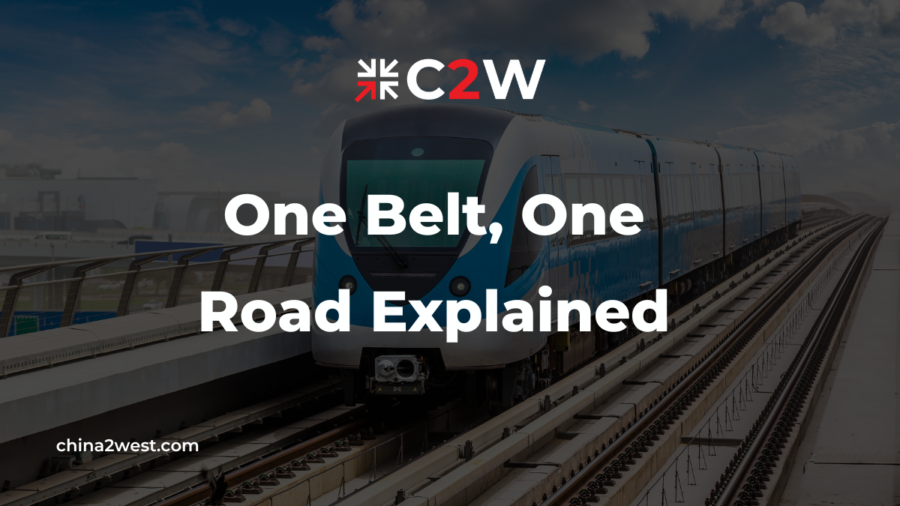Last Updated: April 28, 2024
The “One Belt, One Road” initiative, also known as the Belt and Road Initiative (BRI) or the New Silk Road, is a comprehensive global development strategy implemented by the Chinese government.
The concept was first introduced by Comrade Xi Jinping during his speech at Nazarbayev University in Kazakhstan on September 7, 2013. In this address, he advocated for the creation of the “Silk Road Economic Belt” to strengthen economic ties, deepen mutual cooperation, and expand development opportunities across Eurasian nations through innovative collaboration models.
The Belt and Road Initiative was two-pronged:
- The Silk Road Economic Belt
- The 21st Century Maritime Silk Road
As of 2023, the initiative has expanded significantly, with 152 countries and 32 international organizations having signed over 200 cooperative agreements with China. This expansion extends the initiative’s reach beyond the Eurasian continent to include regions such as Africa, Latin America, the Caribbean, and the South Pacific.
What Is Beijing Trying to Achieve with This Initiative?
Beijing’s goals with the Belt and Road Initiative (BRI) are multifaceted and strategically significant both economically and politically. Here are some of the primary objectives China aims to achieve through this initiative:
Economic Growth
By building infrastructure such as roads, railways, and ports, China aims to stimulate economic growth in less developed regions of its own country and in participating countries. This development is expected to open up new markets for Chinese goods, promote Chinese construction and technology sectors, and ensure stable resource imports.
Geopolitical Influence
The BRI is a tool for China to expand its influence across Asia, Africa, and Europe, positioning itself as a central player in global affairs. By investing in and building infrastructure in various countries, China strengthens its ties and increases its sway over these regions.
New Investment Opportunities
Chinese companies gain new opportunities abroad, helping them to grow and internationalize. This is particularly important for China’s domestic economic rebalancing from an investment- and export-driven model to one fueled by diverse global engagements.
Does This Initiative Involve a Free Trade Area or The Creation of Another Kind of International Institution?
No, this is clearly not a regional free trade area, and it involves no binding state-to-state agreements. Instead, it is at its heart a pledge by China to use its economic resources and diplomatic skills to promote infrastructure investment and economic development that more closely links China to the rest of Asia and onward to Europe. In this regard, it reflects China’s preference to avoid if possible formal treaties with measurable compliance requirements in favor of less formal arrangements that give it flexibility and allow it to maximize its economic and political skills.
What Are the Potential Benefits to Asia?
The “One Belt, One Road” has been referred to as China’s version of the Marshall Plan, a comparison Beijing has sought to downplay as being freighted with geopolitical undertones that it claims are absent in its initiative. Motivations aside, the initiative is a powerful illustration of China’s growing capacity and economic clout—and the Xi administration’s intent to deploy them abroad. Properly implemented, the projects that comprise the Belt and Road could help enhance regional economic growth, development, and integration. According to the Asian Development Bank, there is an annual “gap” between the supply and demand for infrastructure spending in Asia on the order of $800 billion. Given that infrastructure is at the heart of the Belt and Road, there is room for the initiative to play a constructive role in regional economic architecture. In addition, if this leads to more sustainable and inclusive growth, it could help strengthen the political institutions in the region and reduce the incentives and opportunities for terrorist movements.
The Top-Level Framework of the “Belt and Road” Initiative
China’s proposed framework for the Belt and Road Initiative, characterized by “six corridors, six roads, multiple countries, and multiple ports,” aligns with the initiative’s focus on cooperation and spatial organization. This framework offers a structured pathway for countries looking to engage in collaborative efforts under the Belt and Road Initiative.
The Belt and Road’s Six Economic Corridors
A central aspect of the BRI is the development of six economic corridors, which are designed to facilitate trade, improve transportation infrastructure, and foster economic collaboration between different regions. These corridors include:
The New Eurasian Land Bridge: This corridor connects Eastern Europe with Eastern China through Central Asia. It aims to provide a more direct route for goods traveling by rail between the two regions, bypassing traditional sea routes.
The China-Mongolia-Russia Corridor: This route aims to enhance connectivity between China and Russia via Mongolia. It focuses on developing transportation links and energy cooperation, boosting economic growth in the region.
The China-Central Asia-West Asia Corridor: This corridor stretches from Western China to Turkey, passing through Central Asia and the Middle East. It aims to improve trade links and energy cooperation, connecting the rich energy supplies of Central Asia and the Middle East with markets in China and beyond.
The China-Indochina Peninsula Corridor: This corridor aims to strengthen the connection between China and the countries of the Indochina Peninsula (Vietnam, Laos, Cambodia, Thailand, Myanmar, and Malaysia), enhancing regional infrastructure and trade.
The Bangladesh-China-India-Myanmar Corridor (BCIM): This corridor seeks to improve trade and transport links between China and India via Bangladesh and Myanmar, creating economic opportunities and fostering closer ties among the participating countries.
The China-Pakistan Economic Corridor (CPEC): Perhaps the most well-known and strategically significant, this corridor involves major infrastructural developments within Pakistan, including roads, railways, and energy projects. It aims to connect Gwadar Port in Pakistan with Xinjiang in China, providing China with direct access to the Arabian Sea and facilitating oil imports.

